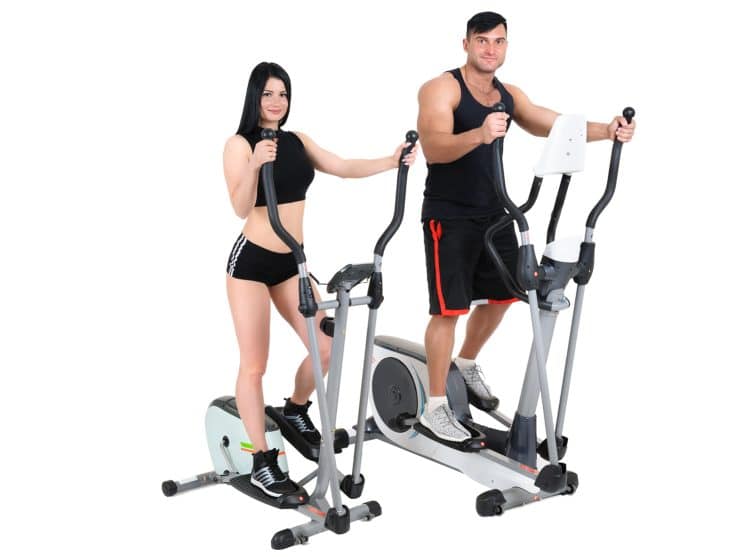The average speed on an elliptical varies by intensity: light intensity equates to 3.75 mph (127 steps/min), moderate intensity to 4.0 mph (132 steps/min), and vigorous intensity to 4.3 mph (137 steps/min).
An elliptical machine is a popular alternative to running or using a step mill, especially beneficial for people with joint problems. An elliptical machine allows you to monitor your average speed so you can train at a consistent pace.
This article will explore how elliptical machines calculate average speed. We’ll also discuss the importance of tracking average speed and the benefits of elliptical training and provide guidance on buying an elliptical.
What is an Elliptical, and Why Do You Need One?

If you’ve ever stepped inside a commercial gym, it’s a sure bet that you’ve seen ellipticals in action. They’re those upright cardio units that allow you to get in a stride workout by moving in an elliptical motion.
There are a couple of significant benefits to using an elliptical. Firstly, they have a very low impact (especially in comparison to a treadmill or an exercise bike). So, if you have ankle, knee, or lower back concerns, an elliptical will allow you to get an effective cardio workout.
The other benefit of elliptical training is that it allows you to target the muscles at the back of your legs (glutes, hamstrings, calves) more than most other forms of cardio. This is especially true when you put the elliptical into reverse stride action.
Level Up Your Fitness: Join our 💪 strong community in Fitness Volt Newsletter. Get daily inspiration, expert-backed workouts, nutrition tips, the latest in strength sports, and the support you need to reach your goals. Subscribe for free!
Elliptical machines also have movable handles. These allow you to move your arms back and forth as you stride. This involves the upper body in the workout, providing a greater overall calorie burn.
How Does an Elliptical Monitor Average Speed?
An elliptical machine provides an average workout speed at the end of your session and presents it as part of the summary of your workout. Throughout your workout, the machine’s computer will process thousands of data points, recording your speed every three or four seconds.
As well as providing a summative average speed for your workout at the end of your session, most ellipticals will also provide you with a running average of your speed as you do the workout.
Ellipticals in the United States will record speed in miles per hour as their default setting. However, many will also allow you to switch to kilometers per hour. The monitor will display your average speed to one decimal point.
Benefits of Monitoring Your Average Speed
Monitoring your average elliptical workout speed is important to your fitness program. Here are four reasons why you should take notice of this reading:
1. Monitoring Progress
A readout of your average speed gives you a tangible metric to use for setting your workout goals. You can set realistic goals to increase your average elliptical speed over time and monitor your progress.
Keeping an eye on your average speed will allow you to get visual proof of improvements in your cardiovascular fitness level over time. This can motivate and encourage you to stay consistent with your workouts.
2. Workout Intensity
The readout of your average speed at the end of your workout will tell you how intense your session was. This will then guide you on progressing your intensity to optimize your calorie burn and cardio benefits.
Keeping an eye on your average speed allows you to customize your workouts for low-, medium-, and high-intensity sessions.
3. Accountability
Monitoring your average speed keeps you accountable. Rather than simply going with how you feel, you will have solid data to assess your performance. Sticking with a consistent speed is also a sign that you are using proper, consistent form on the elliptical machine.
4. Interval Training
You can utilize this data point in your interval training workouts when you monitor your average speed. Interval training can boost your cardio results and calorie burn.
Average Speed vs. Heart Rate
Average speed and heart rate are both vital fitness data points. Your average speed more directly indicates how fast you’re pedaling and moving the handles of the elliptical machine. It also allows you to set speed-related goals.
Heart rate data provides insight into the cardiovascular stress your training session puts on your body. It indicates how hard your heart works to provide oxygen to your muscles.
Monitoring your heart rate during a workout allows you to train within a specific target heart rate zone. There are six heart rate training zones, each associated with a different training intensity and specific goals, such as fat-burning or aerobic endurance.
Heart Rate Target Training Zones
| Training Zone | Intensity Level | Heart Rate Range |
| Resting | Very Light | 50-60% of Max HR |
| Warm-up | Light | 60-70% of Max HR |
| Fat Burning | Moderate | 70-80% of Max HR |
| Aerobic | Vigorous | 80-90% of Max HR |
| Anaerobic | Near Maximum | 90-95% of Max HR |
| Maximum | Maximum Effort | 95-100% of Max HR |
What to Look Out For When Buying an Elliptical
Home elliptical machines represent an affordable cardio training option that is especially beneficial for people wanting a low-impact training option. Here are some buying considerations to keep in mind to ensure that you get the best elliptical to meet your needs:
Flywheel
The flywheel is a solid metal wheel that sits either at the front or back of the machine. It is connected to the stride pedals and provides the elliptical motion of your exercise movement.
The weight of your elliptical flywheel will determine the smoothness of your stride action. It will also control the resistance you can generate through your stride. The flywheel weight will also help determine the overall price of the elliptical; the heavier it is, the more you will pay. The minimum flywheel weight you should consider is 17 pounds.
Brake System
A high-quality brake and resistance mechanism will ensure that the machine operates smoothly, is quiet, and lasts a long distance. An eddy current brake system uses magnets against the flywheel to create resistance and braking. It is connected to the computer console so that you can control resistance and braking at the touch of a button.
This system provides smoother movement than a friction-based pad system, in which a couple of abrasive pads tighten on the flywheel. I recommend the former system.

Forward – Backward Motion
Not all ellipticals allow you to reverse your motion so that you walk in reverse. You should look for one that does. The reverse motion targets the glutes, the largest muscle group in your body – and chronically weak in most people.
Arm Movement
To exercise the upper body, you will want an elliptical with movable handles. It should allow full arm movement to extend and contract your biceps and triceps fully.
Adjustable Incline
An adjustable incline will have the effect of changing the stride length while, at the same time, putting more emphasis on the glutes, calves, and front thighs. It will also intensify your workout, so you burn more calories.
Stride Length
The length of your stride is critical in determining your workout’s effectiveness (and natural comfort). Obviously, your required stride length will be determined by your height. We suggest investing in an elliptical with an adjustable stride length of at least 16 inches and a maximum of around 22 inches.
Level Up Your Fitness: Join our 💪 strong community in Fitness Volt Newsletter. Get daily inspiration, expert-backed workouts, nutrition tips, the latest in strength sports, and the support you need to reach your goals. Subscribe for free!
Pedal Width / Grip
The pedals should have a non-slip surface while providing sufficient width for a comfortable fit.
Monitor
The monitor in your elliptical needs to deliver an accurate readout of the following training data:
- RPM
- Calories Burned
- Time
- Speed
- Average Speed
- Heart Rate
Look for a backlit LCD screen for easy console viewing. If you want to be entertained while you work out, go for a machine with web connectivity. Most big-name brands (Schwinn, Nautilus, Nordictrack, etc) also pair with the company’s fitness app so you can transfer and analyze your training information.
Elliptical Workouts For Beginners
The key to elliptical training success is consistency. One of the most significant barriers to that consistency is boredom. Here are four different elliptical workouts for beginners to keep your workouts varied and interesting:
1. HIIT Elliptical
One of the things that makes High-Intensity Interval Training so popular is that it is very time-efficient. One of the significant issues with steady-state cardio is that it takes a long time to complete. If you are tight on time, doing 30-40+ minutes of elliptical every workout is probably impossible.
On top of that, that steady-state cardio gets boring very quickly.
HIIT corrects that.
Most routines are 20 minutes or less. But that doesn’t mean they’re easy!
One of my favorite HIIT workouts on an elliptical involves doing 45 seconds of high-intensity, incline training, immediately followed by 90 seconds at a low intensity and a reduced incline. This is repeated with no breaks for several rounds.
Here’s how to do it:
- 2-minute warmup, 4% incline, low intensity
- 45 seconds high intensity, 12% incline
- 90 seconds low intensity, 4% incline
- (repeat the above five times)
- 2 minutes cooldown, 4% incline, low intensity
The whole workout will only take about 15 minutes, but you will be drenched in sweat by the end of it. Because you can pick your own intensity, this workout suits beginners and more advanced trainers.
2. Increase The Incline
One of the ways to make your elliptical workout more interesting is to play around with different inclines. Increase the incline by two percent every two minutes, then pyramid the incline back to the original level.
Here’s an example:
- 0-2 minutes: 6%
- 2-4 minutes: 8%
- 4-6 minutes: 10%
- 6-8 minutes: 8%
- 8-10 minutes: 6%
- 10-12 minutes: 8%
- 12-14 minutes: 10%
Play around with the speed and choose what works best for you. When the incline is lower, you should pick a higher speed, and vice versa. Alternatively, you can keep to a constant speed throughout the workout.
3. Forward/Backward Motion
The best elliptical machines can pedal forward and backward. This feature makes your workout more interesting and works your muscles differently.
Pedaling backward will target your glutes and hamstrings more, while forward pedaling will target your quadriceps. You’ll work your lower body more effectively by alternating between forward and backward pedaling throughout your workout.
For example, you can go backward every third set or use your “rest” set in a HIIT workout for back rotations. Or, for a total back/front workout, select your incline, then alternate your pedaling direction every two minutes.
4. Hands-Free
Doing elliptical training hands-free will make your core work harder to stabilize your body. Not using your hands will force your abs to work overtime. Your abdominals are key core stabilization muscles. The faster you pedal, the harder your abs will work to keep your body stable.
Hands-free elliptical training is like running without the impact of lower body stress.
Elliptical Training for Runners
Doing a couple of elliptical sessions per week provides runners with some variety in their training. The elliptical works the same muscle groups as running, giving you another training option during inclement weather or when you want to change things up.
Working out on an elliptical has the added advantage of being low-impact. This makes it an excellent option for runners returning from an injury.
Here are some tips for runners using the elliptical trainer:
- Set a goal pace of 90 RPM. This aligns with the ideal pace of 180 steps per minute for runners. You will probably have to work up to this pace as you get used to the unique motion of the elliptical, so begin with a lower pace and work up to 90 RPM.
- Challenge yourself by varying the intensity level throughout the workout.
- Don’t get distracted. You need to focus on what you’re doing on an elliptical. Develop your mind-muscle connection, thinking about and feeling your working muscles.
- Avoid holding on the side handrails for balance. Using the movable handles is fine, but try not to lean on them to support your body weight.
Supplemental Elliptical Training Workouts for Runners
Here are three elliptical workouts runners can include in their training:
Tempo Workout
- Begin with a twenty-minute warm-up at a resistance level of four and a low intensity.
- Increase the resistance to seven for five minutes after twenty minutes.
- Concentrate on squeezing your quadriceps and engaging your core as you pedal.
- After that, drop the resistance to level three for three minutes.
- Complete your workout with six minutes at level seven resistance.
Interval Workout
- Start with a ten-minute warm-up at a resistance level between one and four.
- Begin the first of eight intervals, which involves 90 seconds of high-intensity work at a level between 10 and 15.
- Recover for 90 seconds at low intensity at level three between each high-intensity bout. Complete the workout with eight minutes at a moderate intensity level of six.
Uphill Climb Workout
This is a 60-minute hill simulation workout where you change the resistance level every three minutes. You also adjust the angle of your elliptical pedal motion every five minutes. The angle should go up every five minutes for the first half hour and then decrease for the final half hour.
I recommend adding a weekly elliptical trainer workout to your running workout program. Rotate throughout the three beginner workout programs that are described above.
Wrap-Up
Monitoring your average speed using an elliptical trainer will keep you on track with your workout. You’ll be able to assess the intensity of your workout, set and monitor training goals, and track your progress over time.
Remember that consistency is the key to elliptical training success. I recommend doing three or four elliptical sessions per week. Experiment with the workouts given above and then record your average speed in your workout journal.
Aim to gradually improve your average speed on the elliptical, and you’ll make steady progress toward your fitness goals.











